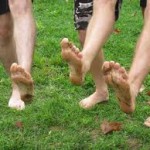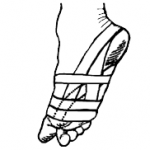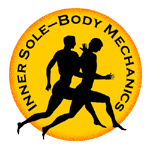About Inner Sole

Inner Sole/Body Mechanics is dedicated to everyone committed to improving their biomechanical efficiency. Whether you are a triathlete training for an Ironman, a weekend warrior, or a moderately active person who sits a lot in front of a computer, you will find valuable information on how to use … [Read More...]
The Foot

Introduction If you are suffering from a sore arch, a sore heel, or any other foot-flattening related injuries, the following taping will probably give you immediate relief. At worst, you should experience a reduction in soreness. When the foot flattens or pronates, it gets longer. Stop the … [Read More...]
About the Book

In 1975 I considered going to graduate school in physical education at Springfield College in Springfield, Massachusetts. I loved the feel of the school where students wore sweats to class, practicing what they were studying. Upon graduation, they were launched into front-line professional roles, … [Read More...]
From the Book
“Common Sense Guide to Mechanical Health” video
Before I publish the book, look at the link below to see a talk I gave at the 2007 IDEA* annual conference in San Diego. The ideas in “Common Sense Guide to Mechanical Health” are essentially the same as those in the book, although naturally abbreviated. And of course ten years later the book … [Read More...]
Removed the book chapters and will publish as one
I have been told the way I had posted the individual chapters the book was too easy to steal (so I have removed them), and I have been advised to post it as one unit, perhaps on a site that will post it for free – looking into that :-) … [Read More...]

Chat 22, Shoulders, Arms and Hands
Rolling two small balls in hand relieves forearm stress To Read Chpt 22, click on: … [Read More...]

Chpt 21, Neck and Head
Upper vertebrae (mid back and neck) viewed from back To read Chpt 21, click on … [Read More...]
We Are All Athletes
Everyone suffers from sore feet, aching knees and a strained back at some time in their lives. In common, we face the same modern environment.
We might be serious athletes who invest time and energy in our workouts, or someone whose most aggressive activity is walking around the block. Being a serious athlete is like taking part in an accelerated experiment. You do more in a shorter period of time so the effects of an imbalance show up faster. If you are not particularly active, the imbalance will still give you problems, perhaps as an arthritic hip in your mid-fifties.
Serious athlete or not, everyone will be healthier if they improve their mechanics as early as possible.
We already spend a lot of time, effort and money dealing with the negative effects of our lifestyle, but our efforts are often not effective. I hope to offer a simple guide that can help you live a better quality of life.
About Doug Stewart
Dr. Doug Stewart, founder of Inner Sole/Body Mechanics has worked in the area of lower body mechanics for years. His background includes Ph.D. in biomechanics and working as Director of Research for Reebok.
"I went through school on a track scholarship and was injured a lot," says Stewart. "I was running the same 100 miles a week as other members of the team who weren't getting hurt. I recognized there was a difference in the way people run."
His injuries motivated him to study the mechanics of movement and the impact of footwear on these mechanics.